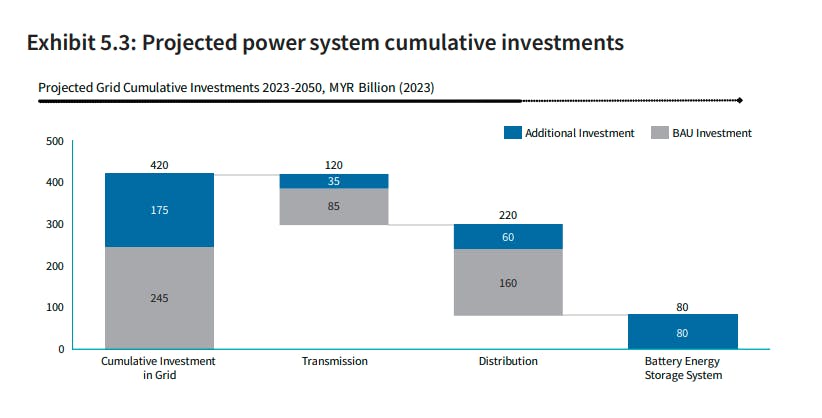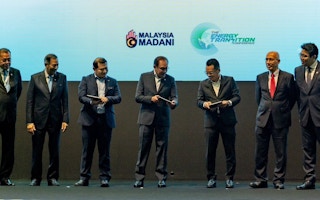Just two months after stressing the importance of hydrocarbons in Malaysia’s energy landscape, prime minister Anwar Ibrahim has launched a national policy document that aims to pivot the country away from fossil fuels.
The National Energy Transition Roadmap (NETR) is designed to accelerate Malaysia’s energy transition and ensure a shift “from a traditional fossil fuel-based economy to a high-value green and sustainable economy,” Anwar said.
“Since I took office [in November 2022], the government has reviewed its decarbonisation plans to see if we could do more,” he said at the launch of the roadmap on Tuesday, which was held at the Energy Transition Conference organised by national utility company Tenaga Nasional.
“There are vast opportunities that will come with clean energy transitions across the supply chain,” said Anwar, citing solar panel manufacturing, battery energy storage and electric vehicle (EV) charging facilities, among others. “All of these developments provide impetus for us to restructure our economy, while boosting investment opportunities in green growth.”
These comments come two months after Anwar spoke at another energy conference in late June 2023, where he defended the prominence of natural gas in Malaysia’s energy mix even as the country transitions towards cleaner energy. However, the prime minister acknowledged in his latest speech that the burning of fossil fuels, “namely coal, oil and gas” has emitted a “huge amount of greenhouse gas”, making the energy sector responsible for Malaysia’s largest source of emissions.
“For Malaysia, while we have a vibrant oil and gas industry, the country recognises the importance of renewable energy sources,” said Anwar, who also witnessed the signing of a memorandum of understanding between national oil company Petronas and Tenaga Nasional for a formal collaboration to explore the implementation of carbon capture, utilisation and storage (CCUS) solutions for gas-fired power plants.
CCUS was among the six policy levers named in the first part of the NETR, which also featured 10 flagship projects by the public and private sectors to facilitate the energy transition. The other levers included energy efficiency, renewable energy, hydrogen, bioenergy and green mobility.
In 2020, Malaysia emitted 367.76 million tonnes of carbon dioxide equivalent (MtCO2e), which made up 0.8 per cent of global emissions, according to data from tracking tool Climate Watch. The figure represented just over a 1 per cent decrease from its record high emissions of 374.09 MtCO2e in 2019.
Malaysia has made a commitment to achieve net-zero emissions by 2050 and in 2021, increased its nationally-determined contribution (NDC) target from 35 per cent of emissions intensity in gross domestic product by 2030 to 45 per cent, with the earlier target having been set in 2015
However, the country has yet to publish a long-term strategy for achieving its NDC and although it has strengthened its emissions targets, Malaysia has yet to add sectoral targets, policies and actions, according to Climate Watch.
“
A cleaner energy mix and energy efficiency would future-proof our industries, so that we are prepared for a world where money responds to the greenest products.
Rafizi Ramli, Minister of Economy, government of Malaysia
As part of the second half of the roadmap, Anwar, who is also finance minister, pledged RM2 billion (US$430 million) of government funding towards the National Energy Transition Facility, which will enable “catalytic blended finance” for energy transition projects that are “marginally bankable or yielding below-market returns”, he said. These include investments in the EV value chain, hydrogen and CCUS technologies.
The facility will blend public, private and philanthropic funds to mobilise additional private capital to the initial sum, said economy minister Rafizi Ramli.
“The seed fund could be useful to bolster some of the investments risks at the start [of renewable eneryg projects] and support players who are willing to build infrastructure,” said Alicia Tien, chief executive officer of Beijing-based consulting firm Asia Discovery with a focus on renewable energy across Asia Pacific.
“It would also be helpful for the government to plan ahead and start investing in research and development for projects that the market would need in the near future, say five to seven years later,” she told Eco-Business, citing as examples lithium battery recycling plants, which could serve the changes in EV batteries and battery manufacturing plants.
Overall, the NETR is slated to uplift Malaysia’s economy by up to 15 per cent and create 350,000 jobs with 70 per cent of income gains to be enjoyed by low- and medium-income households, said Rafizi. The government’s “stretched targets”, which include an increase in the target renewable energy ratio to 70 per cent by 2050, 80 per cent of EV penetration and energy efficiency savings of 22 per cent, are designed so that “slight discomfort” would drive creativity and innovation in reaching them.
“A cleaner energy mix and energy efficiency would future-proof our industries, so that we are prepared for a world where money responds to the greenest products,” said Rafizi.
“The roadmap shows the government’s commitment to develop Malaysia as a regional energy hub (and) position the development of renewable energy projects as a strategy to strengthen Malaysia’s economy. I believe it will speed up renewable energy adoption and attract foreign investments,” said Tien. She described the NETR as a “great investment opportunity”, particularly for Chinese investors and companies with mature technologies in renewables.
The government estimates some RM1.2 trillion (US$258 billion) in investments is needed to achieve these targets. Government revenue, however, continues to be reliant on fossil fuels, with the Ministry of Finance projecting in its 2023 Economic and Fiscal Outlook Report that petroleum-related revenue would account for 20.9 per cent of government revenue in 2023.
“Considering Malaysia’s current state of immature decarbonisation technologies, our progress will significantly hinge on alternative energy sources and robust regional and international collaboration,” said Anwar. He added, however, that the government is optimistic that the NETR will succeed in balancing the different prongs of the energy trilemma, namely sustainability, security and affordability.
As Prime Minister, Anwar will also lead Malaysia’s National Energy Council, which had been announced under the National Energy Policy launched during the previous government’s regime in 2022. According to Rafizi, the council plans to hold its first meeting with its committee in October this year and is the “strongest signal yet” of a move towards implementation of energy transition plans.

Malaysia’s National Energy Transition Roadmap estimates that investments of up to RM1.3 trillion (US$280 billion) will be needed to meet all its energy transition financing needs. Source: NETR
Accelerated energy exchange
On the regional front, Anwar positioned Malaysia as Asean’s “energy hub” and highlighted the government’s decision in May to lift its ban on renewable energy exports in May, which had been established under a previous regime in 2021. The actual trade of renewables, however, is expected to be conducted via an energy exchange, the establishment of which is being “accelerated”, said Anwar.
“Originally it was (to be launched) at the end of the year, but Rafizi insisted it should be earlier. Good luck to you,” Anwar said, directing the joke at the economy minister during his speech. However, he also said that the establishment of the exchange should be accelerated because Malaysia “cannot be left behind.”
The energy exchange must also be a physical one, said Rafizi, who added that a single market aggregator will need to be established so that trade is transparent and trustworthy. Although the government has yet to name the aggregator, the Energy Commission of Malaysia is “mobilised and very focused on getting the energy exchange off the ground,” said its chairman, Mohammed Rashdan.
“The devil is actually in the details, on the specific procedures and policies of what that exchange entails,” he said on a panel at the Energy Transition Conference.
The biggest challenge of all, Rashdan added, is the state of Malaysia’s grid, which is currently unprepared to accept the envisioned surge in renewables due to their intermittency. The necessary technologies to address this, particularly energy storage solutions, require investments “just shy of about RM200 billion (US$43.1 billion)”.
“That is also a key component of the energy exchange, (which is) when we can tap into other markets and higher prices. Hopefully that will fund the system,” said Rashdan.

Malaysia will need roughly RM175 billion (US$38 billion) of additional investments to bolster its electricity grid to support its planned renewable energy capacity. Image: National Energy Transition Roadmap
Join the conversation on how the Malaysia can unlock sustainable finance for a just energy transition. Register here for Unlocking capital for sustainability Malaysia on September 8, 2023.








